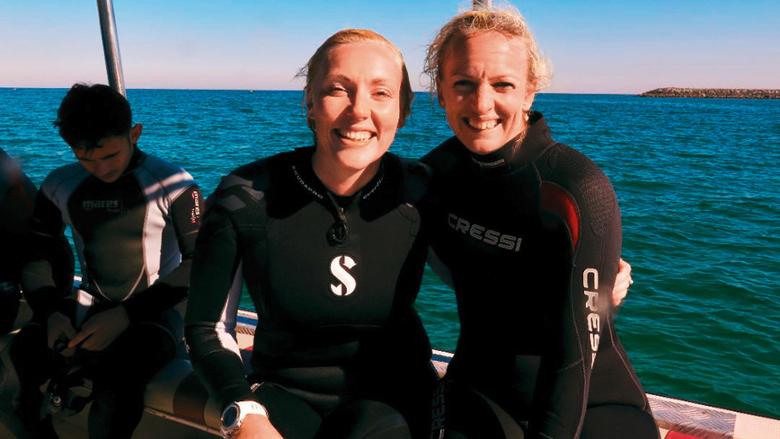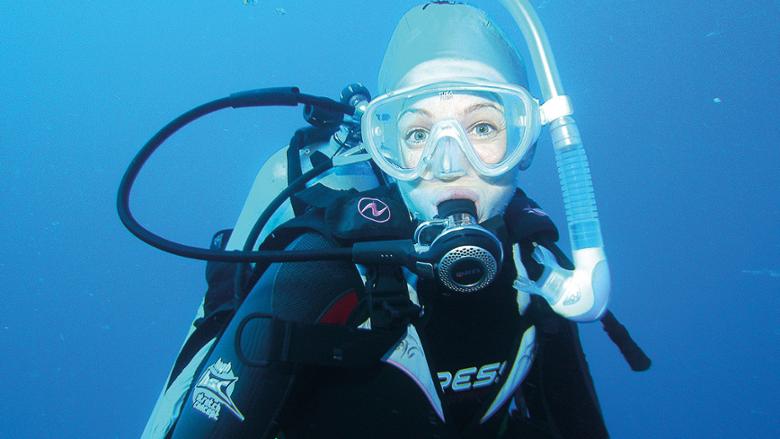
There was no mistaking it – at around five metres long, with its flattened head and blunt nose, and the distinctive eye-catching pattern of stripes and pale yellow spots set against a greyish brown skin tone it could be only one creature: the whale shark, the largest species of fish in the world.
"It was a sight that blew me away," says UAE-based marine conservationist Natalie Banks, describing her encounter with a juvenile whale shark on her very first openwater dive in the azure blue waters off the coast of Perth in Western Australia. "I was 24, and still training as an openwater diver. We were several feet below the surface of the warm, clear ocean, practicing mask removal and honing basic scuba diving skills. We were not expecting to see anything much as we were in a place with only sand and no corals."
It was as she was surfacing that the form of the juvenile whale shark loomed above. Seconds later, she was within a few feet from it. "I watched mesmerised at the gentle curving mouth under its broad head as it appeared to gracefully glide in the water. Witnessing this majestic creature in its natural environment was both awe-inspiring and humbling; I fell in love with the marine environment and whale sharks instantly."
Natalie, who has launchedan an initiative called Azraq to raise awareness of marine conservation issues in the UAE, says her love for the marine environment began 15 years ago when she first donned a mask and snorkel and saw firsthand the visual wonders that lay beneath the ocean’s surface. "It was a different world out there," she remembers. "The vivid colours and teeming life seemed magical; it was breathtakingly beautiful."
Introduced to snorkelling by her husband, Natalie accompanied him on group tours and listened in wonder as divers narrated what they saw in the depths of the ocean. "All I wanted then was to know how to do that," she says, and soon plunged right in to train as a certified scuba instructor.
As her fascination for sharks grew, like most divers around the world, Natalie too yearned for shark sightings on her dives, even if it was just a Port Jackson (normally found in tropical and temperate waters) or a Wobbegong (found in shallow temperate and tropical waters of the western Pacific Ocean)".
Around this time, in 2013-14, due to increased human-shark encounters in Western Australia, the state government in her native state decided that the best way to protect beach users was to kill sharks, by dropping drum lines which is a buoy with a hook and bait. "These bait lines were intended to target three shark species of three metres in size or greater; the Bull, Tiger and the protected Great White," explains Natalie. "But hooks and baits don’t distinguish between shark species or their size. I was very vocal in speaking up against this initiative and organised rallies with others at the Cottesloe beach to protest against this indiscriminative culling."

More than 8,000 marine lovers turned up for the rallies in what was then called the “largest protest for a single wild animal species in history". Footage of a female tiger shark being dragged and then shot in the head four times caused outrage not just Down Under but across the world. "I had stood up against the initiative as an ordinary citizen wanting to protect our marine life but the action soon turned global as several countries spoke out against this policy following which it was revoked."
The drumline protests turned out to be a defining moment in her life as they paved the way for the path she would since follow. Quitting her career as a media adviser, Natalie devoted herself fully to marine conservation activities with Sea Shepherd Australia, a direct-action ocean conservation organisation. Commencing work for the Operation Apex Harmony campaign, she concentrated on Australia as a whole, and worked to prevent the lethal measures some states were taking to protect beach users, urging them to resort to alternative or non-lethal measures instead. It was while working on implementing positive policy changes in New South Wales that her husband decided to take up a promising job opportunity in Dubai. Although Natalie had initial misgivings on giving up what she enjoyed doing, she took up the challenge of consolidating her conservation expertise to a new territory.
"When I came to Dubai I was aware that turtle conservation was very big here. I therefore began to look for a gap in marine conservation to focus on. I didn’t need to look far because walking along the coastlines, it was evident that marine litter was an issue here just as it is around the globe. I felt that a campaign focused on marine debris, particularly single-use plastic, was needed and this became our number one focus when we launched Azraq this year."
Azraq, Arabic for ‘Blue’, is a not-for-profit organisation that focuses on issues such as those associated with marine debris, she explains. "Our primary aim is to raise awareness on reducing the top 10 items generally found during a coastal clean-up. Not many people realise that 30 to 40 per cent of what we gather are cigarette butts. Just because these are tiny and blend in with the colour of the sand, it may seem ‘invisible’; but if these were coloured neon pink, you would see multitudes of it strewn on beaches.’
Apart from being a health hazard, cigarette filters have a component of plastic called cellulose acetate that is extremely toxic for the environment; it is also nonbiodegradable. "It also contains several chemical ingredients including arsenic, lead, nicotine and ethyl phenol, all of which leak into aquatic environments. According to World Health Organisation estimates, 4.5 trillion cigarette butts are littered worldwide every day and end up in our oceans, waterways and coastlines."
Also accounting for almost 60 per cent of the rubbish in the marine environment are the ubiquitous food and beverage plastic containers, in addition to plastic bags and straws, she adds. "Marine debris is an eyesore. It is harmful not just to the environment but can also kill and injure wildlife through ingestion and entanglement."

Azraq’s mission is to refuse, reduce, reuse, recycle and repurpose single-use items which largely end up as marine debris in the oceans, says Natalie. "Plastics pose a modern dilemma as they are deeply entrenched in our lifestyles today. Paying just a little bit more attention to the way in which we use some of these mass-produced single-use products – often more out of a habit than a necessity – can make a huge difference to our environment. A classic example is the plastic straw. These seemingly innocuous items cause irreversible harm to marine life. In 2015, a video showing a straw lodged inside the nose of an Olive Ridley sea turtle in Costa Rica served as a catalyst for individuals and organisations to compel people to stop using them."
In February this year, Azraq joined hands with Freedom Pizza, through the #stopsucking initiative on getting food outlets to rethink the need for plastic straws. This movement has seen organisations like Jumeirah Group and Gates Hospitality follow in the footsteps of Freedom Pizza, by eliminating plastic straws from their restaurants and hotels.
In June, Azraq also screened the award-winning documentary Straws to highlight how billions of non-recyclable plastic straws litter streets and wash into oceans each day. "Nearly everything we do at Azraq currently is focused on the removal of single-use plastics from daily life. I believe we need to use it wisely. It is estimated that by 2050, the oceans will contain more plastic than fish – by weight, and that is a scary statistic."
Why are the oceans so important and why should we care about it? "The oceans are our life support system and the largest ecosystem on Earth," explains Natalie. "Every second breath we take – the first is from trees – we can attribute it to the ocean and to the planktons in the oceans. They absorb the carbon dioxide we emit and generate half of the oxygen we breathe. Oceans make up 70 per cent of the planet and contain more than 97 per cent of the world’s water. We need healthy oceans as our survival as a race depends on the diversity and productivity of the oceans and its creatures."

With the way mankind has ravaged the oceans, it is time to ponder perhaps whether we have gone too far, she says. "Our hope today lies in the youth and the younger generation who are more likely to be creating solutions to alleviate the damages inflicted on the marine environment.
"Precisely because of this, Azraq works with children in the UAE to educate them and raise awareness about making informed decisions. What empowers me and motivates me are the children who, unlike adults, have no barriers in their thinking – anything is possible they believe, and I like to harness the potential of that outlook."
Calling herself an ocean optimist, Natalie says, "I have to be an optimist. I wouldn’t be able to do the work I do if I didn’t have hope. It is also true that most people, when they realise the implications of their lifestyle habits on the marine ecosystem are willing to make the change for they do not want to go to polluted beaches or see animals being killed. I believe there is always something that you can do to influence change."
It is easy to be disheartened by troubling statistics or even be weighed down by the size of the ocean and your role in helping to conserve just a tiny portion of it, she adds.
"So, whenever anyone reaches that point, my advice is to go back to the ocean and remind yourself of why you wanted to get involved in the first place. For me, just the memory of the first time I saw that juvenile whale shark is motivation enough to carry on."
Close encounters
While diving at a coral reef in Egypt with my husband and several others, I was swimming against the current, feeling tired and low on air when I saw a large shadow above me. It was a dolphin! It came down to where we were, swam right up to me and for a few brief seconds, looked straight into my eyes. It was hardly five seconds, but the beauty of that moment stays with you forever. Sometime later, a whole pod of 17 dolphins including two juveniles came up to us, checking us out for almost three minutes.
In another incident, during the Western Australian government’s shark culling activity, I was witness to tiger sharks being caught and killed. Up on the boat, we prayed for the ensnared creatures to be less than the legally allowed 3 metre length. I remember one particular tiger shark – an extremely beautiful creature with its vivid colours and stripes – that was initially announced as being dead. It had even been tagged as deceased but just as the Department of Fisheries in Western Australia were releasing it back into the water, it suddenly sprung up and looked straight at me. It had so much spunk that it captured my heart completely!
Shark and dolphin conservation in the UAE
As a person actively involved in shark protection and conservation, in the UAE too – through Azraq – Natalie is tackling this subject by conducting workshops at schools to enable children understand the role sharks play in the marine ecosystem as an apex predator. "There are over 30 different species of sharks in the UAE, some of which are not as popular in my home country of Australia," she says. "The UAE is also home to a large dolphin population, particularly in Abu Dhabi and Fujairah. However, not much information is available on their population status including whether they are resident or transitory, and whether the populations are declining. Our volunteers work with scientists here to gather such data and also look into any threats affecting their population."
This article ws originally published on August 2, 2018












